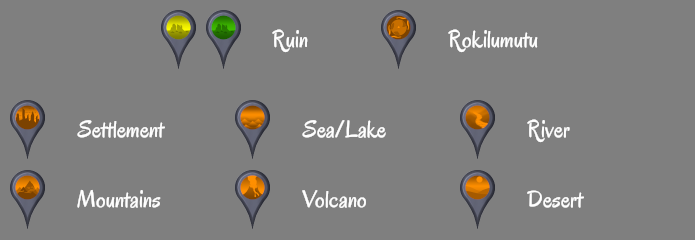Mustik Hamesi
The "Inner Side" is the side of Ranul which faces Kasavoa. Most of the moon's population lives there because this hemisphere's climate is more stable and temperate.
Geography
Defining Features
Mountains
One defining characteristic is that the tallest mountains are found towards the center of this hemisphere, aided by Kasavoa's gravitational pull and the fact that the Kaleidoscope's energy pushes the tectonic plates away from the outer side.Seas
Three major seas are found on this side:- the Zugnur sea to the southwest of the central mountains
- the Zugderi sea in the west
- the Zugzaspo sea in the north-east
Deserts
Most of the land between these seas is covered in reddish sand, save for the fertile bands along the rivers that lead out towards the seas.Metropolises
During the Rilsu civilization, giant cityscapes have evolved in the fertile regions. The so-called zakdengok are characterized by tall high-rise buildings and infrastructure built on the most recent technology.- Tundu-Iv, the moon's capital, located on the north-eastern shore of the Zugnur sea
- Unga-Iv, located on the eastern shore of the Zugderi sea
- Redo-Iv, located on the southern shore of the Zugzaspo sea
Fauna & Flora
Fertile regions are mostly populated by various reptilian species, including the Rul. Large insects are common all over the hemisphere, and the bodies of water are home to numerous fish and crustacean species.
Plant life in the desert areas mostly consists of succulents and cacti. Near bodies of water, broadleaf and palm trees can be found.
Natural Resources
The sand and mountains are rich in iron, accounting for their reddish color. Other major resources include aluminium and silicon.
Wood and various edible plants are harvested in the fertile areas. Insects are kept as livestock, providing the Rul's primary source of protein.
History
The first Rul civilization originated on the inner shores of the Zugnur sea.
Besides the rivers leading to this sea, travel routes were established near the mountain ranges where the distances between bodies of water were shortest.
The shores of the Zugderi sea were the next area to be colonized, with settlements on the opposite side of the mountains following much later.
Over time, the Rilanga Union emerged in the lands around Zugderi, while the remote colonies around Zugzaspo gathered under the name of the Ran-E-Zu Confederation. Conflicts arising between these two factions eventually lead to the Final War, wiping out 97% of Ranul's population and rendering large parts of the once fertile areas uninhabitable for a long time.
The Rilsu civilization began near the central mountains where most of the nuclear shelters had been located. Eventually, technological progress enabled them to undo most of the ecological damage and to spread out over the hemisphere once again.
Type
Landmass
Location under
Included Locations
Inhabiting Species




Comments